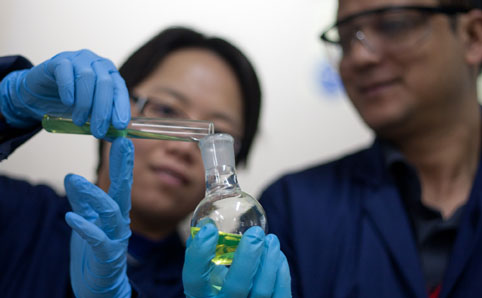 |
A world-class research centre was introduced on Friday 18 November 2011 when the new Chemistry building on the Bloemfontein Campus of the University of the Free State (UFS) was officially opened.
The upgrading of the building, which has taken place over a period of five years, is the UFS’s largest single financial investment in a long time. The building itself has been renovated at a cost of R60 million and, together with the new equipment acquired, the total investment exceeds R110 million. The university has provided the major part of this, with valuable contributions from Sasol and the South African Research Foundation (NRF), which each contributed more than R20 million for different facets and projects.
The senior management of Sasol, NECSA (The South African Nuclear Energy Corporation), PETLabs Pharmaceuticals, and visitors from Sweden attended the opening.
Prof. Andreas Roodt, Head of the Department of Chemistry, states the department’s specialist research areas includes X-ray crystallography, electrochemistry, synthesis of new molecules, the development of new methods to determine rare elements, water purification, as well as the measurement of energy and temperatures responsible for phase changes in molecules, the development of agents to detect cancer and other defects in the body, and many more.
“We have top expertise in various fields, with some of the best equipment and currently competing with the best laboratories in the world. We have collaborative agreements with more than twenty national and international chemistry research groups of note.
“Currently we are providing inputs about technical aspects of the acid mine water in Johannesburg and vicinity, as well as the fracking in the Karoo in order to release shale gas.”
New equipment installed during the upgrading action comprises:
- X-ray diffractometers (R5 million) for crystal research. Crystals with unknown compounds are researched on an X-ray diffractometer, which determines the distances in angstroms (1 angstrom is a ten-billionth of a metre) and corners between atoms, as well as the arrangement of the atoms in the crystal, and the precise composition of the molecules in the crystal.
- Differential scanning calorimeter (DSC) for thermographic analyses (R4 million). Heat transfer and the accompanying changes, as in volcanoes, and catalytic reactions for new motor petrol are researched. Temperature changes, coupled with the phase switchover of fluid crystals (liquid crystals -watches, TV screens) of solid matter to fluids, are measured.
- Nuclear-magnetic resonance (NMR: Bruker 600 MHz; R12 million, one of the most advanced systems in Africa). A NMR apparatus is closely linked with the apparatus for magnetic resonance imaging, which is commonly used in hospitals. NMR is also used to determine the structure of unknown compounds, as well as the purity of the sample. Important structural characteristics of molecules can also be identified, which is extremely important if this molecule is to be used as medication, as well as to predict any possible side effects of it.
- High-performance Computing Centre (HPC, R5 million). The UFS’ HPC consists of approximately 900 computer cores (equal to 900 ordinary personal computers) encapsulated in one compact system handling calculations at a billion-datapoint level It is used to calculate the geometry and spatial arrangements, energy and characteristics of molecules. The bigger the molecule that is worked with, the more powerful the computers must be doing the calculations. Computing chemistry is particularly useful to calculate molecular characteristics in the absence of X-ray crystallographic or other structural information. Some reactions are so quick that the intermediary products cannot be characterised and computing chemistry is of invaluable value in that case.
- Catalytic and high-pressure equipment (R6 million; some of the most advanced equipment in the world). The pressures reached (in comparison with those in car tyres) are in gases (100 times bigger) and in fluids (1 500 times) in order to study very special reactions. The research is undertaken, some of which are in collaboration with Sasol, to develop new petrol and petrol additives and add value to local chemicals.
- Reaction speed equipment (Kinetics: R5 million; some of the most advanced equipment in the world). The tempo and reactions can be studied in the ultraviolet, visible and infrared area at millisecond level; if combined with the NMR, up to a microsecond level (one millionth of a second.
Typical reactions are, for example, the human respiratory system, the absorption of agents in the brain, decomposition of nanomaterials and protein, acid and basis polymerisation reactions (shaping of water-bottle plastic) and many more.